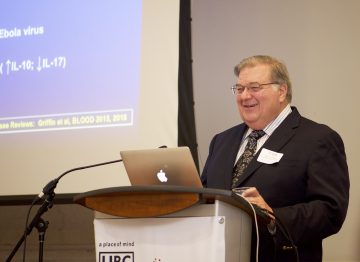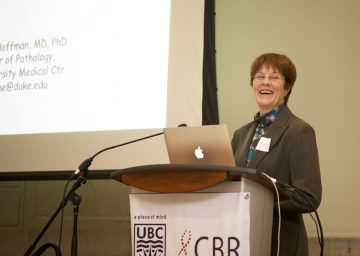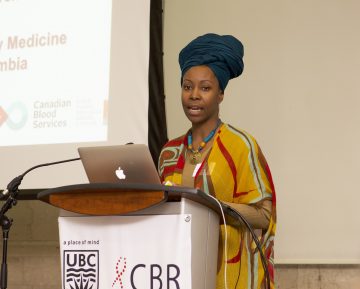
 By Bronwyn Lyons, PhD Student, Strynadka Lab & Tseday Tegegn, PhD Student, Pryzdial Lab
By Bronwyn Lyons, PhD Student, Strynadka Lab & Tseday Tegegn, PhD Student, Pryzdial Lab
At the Centre for Blood Research (CBR), November is associated with the annual Earl W. Davie Symposium. This highly anticipated multidisciplinary symposium was launched 12 years ago by CBR’s founding director Dr. Ross MacGillivray, who was a trainee in Dr. Earl Davie’s laboratory. Attendees include CBR members, local and international researchers, clinicians, students, patients, and industry representatives. Dr. Davie couldn’t join us in person this year but was close by in Seattle and there in spirit via webcast.
The 12th Earl W. Davie Symposium was held on November 15th, 2018 in downtown Vancouver. In addition to Dr. Davie’s 91st birthday, this year marks the 54th anniversary of the discovery of the “waterfall cascade” of blood coagulation. In his opening remarks, the director of the CBR – Dr. Ed Conway – noted that this significant milestone is “essentially a discovery that impacts every medical discipline that exists and affects millions of people around the world!”
The day kicked off with the first of the two keynote speakers. Dr. John Griffin (Scripps Institute) started by focusing on the non-traditional neuroprotective role of the natural anticoagulant, activated protein C (APC), which is mediated through “biased signalling”, or non-canonical cleavage of protease activated receptor 1 (PAR1). To improve therapy in ischemic stroke, Dr. Griffin stressed the importance of combining “reperfusion with neuroprotection”, taking into account the multiple actions of APC.
The morning session started out with Dr. Alvin Schmaier (Case Western Reserve University). He described how factor XII, a coagulation factor in the intrinsic pathway, regulates inflammation by mediating a neutrophil response. Next, Dr. Ed Pryzdial (Associate Director of the CBR and a Canadian Blood Services Scientist) spoke of the extrinsic pathway, describing how enveloped viruses contribute to clot formation and infection through host-derived tissue factor and viral surface glycoprotein C. Involving both the intrinsic and extrinsic pathways of coagulation, Dr. Narcis Popescu (Oklahoma Medical Research Foundation) discussed how disseminated intravascular coagulation develops during anthrax infections, showing that Gram-positive peptidoglycan promotes tissue factor expression by monocytes.
Switching gears, patient and clinician perspective talks on improving comprehensive care for individuals living with sickle cell were given by Storma McDonald, President of the Sickle Cell Association, and Dr. Hatoon Ezzat, Director of BC Provincial Adult Hemoglobinopathy program. Sickle cell-associated pain was their key focus; they emphasized the importance of pain management procedures to help guide physicians when patients visit emergency rooms. Supported by various clinical success stories, Dr. Ezzat also noted the importance of treating with hydroxyurea to reduce pain and improve quality of life for these patients.
With a break for lunch and poster-mingling, the afternoon session began with the second keynote speaker, Dr. Maureane Hoffman (Duke University), who discussed how joint and skin bleeds differ in patients with hemophilia. Dr. Jill Johnsen (University of Washington) provided clinical insights into disease management of hemophilia using genotyping through the My Life Our Future campaign, a targeted approach to understanding this genetically diverse disease. She advocates for comprehensive genetic approaches, to ascertain the complexities of the disease.
The rest of the afternoon provided mechanistic insights into blood clotting and platelet disorders. Dr. Brian Branchford (University of Colorado) deliberated on an exciting inhibitor, UNC2025, which shows promise in mouse models for decreasing platelet accumulation during blood clotting and providing protection from pulmonary emboli. Dr. Walter Kahr (University of Toronto, SickKids) described the genetics and corresponding mechanisms behind rare platelet disorders, such as Gray Platelet Syndrome, a disease that is characterized by abnormally large platelets. Dr. Mark Looney (University of California, San Francisco), wound up the day by wowing the audience with fluorescent images of live cells moving about intact mouse lungs during experimental manipulations and presented compelling evidence of the generation of new platelets in the lung.
The formal part of the day came to a close with Dr. Stefanie Mak, the CBR’s Education Program Manager, presenting awards to trainees for the best posters … some tough decisions, as there were many excellent ones. Indeed, trainees were key participants in this event, delivering four of the day’s talks, and presenting all of the posters. (For more information on the trainee talks, see the Canadian Blood Services R.E.D. blog here). Thanks were extended by Dr. Ed Conway to all of the speakers and organizers who helped make this year’s Earl Davie Symposium once again, a fabulous educational and social experience. Special thanks went to Stefanie Mak and Hana Kim (the CBR’s Office Manager), our sponsors, and of course to Earl Davie, who annually “lends” his name and support for this wonderful opportunity!
To view photos and recordings of the event, click here.





